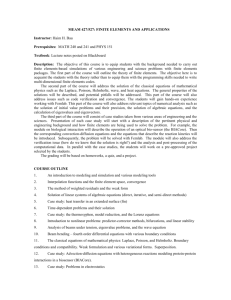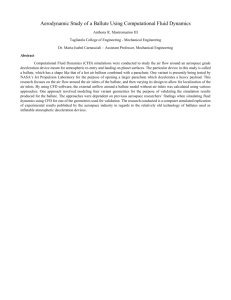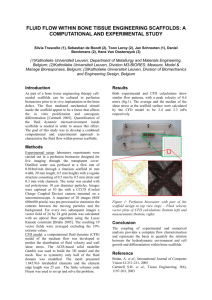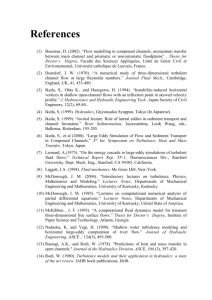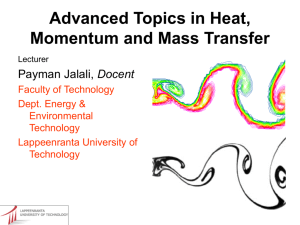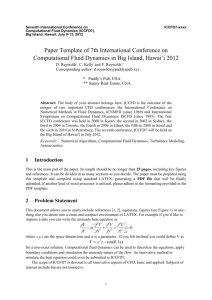Course Outline
advertisement
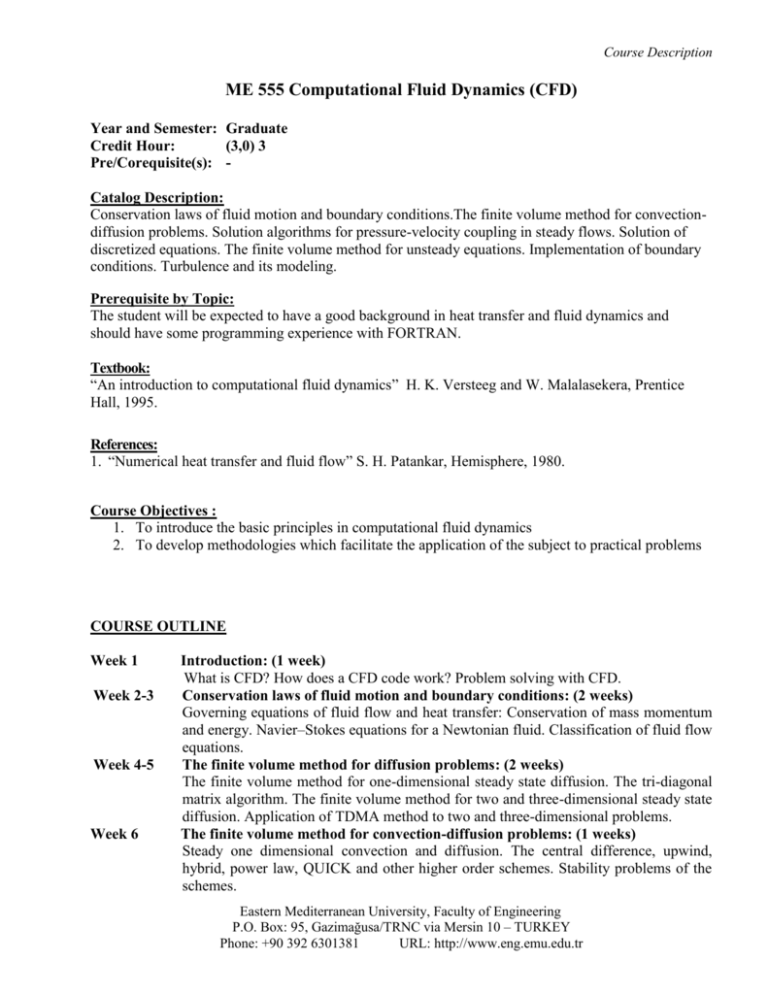
Course Description ME 555 Computational Fluid Dynamics (CFD) Year and Semester: Graduate Credit Hour: (3,0) 3 Pre/Corequisite(s): Catalog Description: Conservation laws of fluid motion and boundary conditions.The finite volume method for convectiondiffusion problems. Solution algorithms for pressure-velocity coupling in steady flows. Solution of discretized equations. The finite volume method for unsteady equations. Implementation of boundary conditions. Turbulence and its modeling. Prerequisite by Topic: The student will be expected to have a good background in heat transfer and fluid dynamics and should have some programming experience with FORTRAN. Textbook: “An introduction to computational fluid dynamics” H. K. Versteeg and W. Malalasekera, Prentice Hall, 1995. References: 1. “Numerical heat transfer and fluid flow” S. H. Patankar, Hemisphere, 1980. Course Objectives : 1. To introduce the basic principles in computational fluid dynamics 2. To develop methodologies which facilitate the application of the subject to practical problems COURSE OUTLINE Week 1 Week 2-3 Week 4-5 Week 6 Introduction: (1 week) What is CFD? How does a CFD code work? Problem solving with CFD. Conservation laws of fluid motion and boundary conditions: (2 weeks) Governing equations of fluid flow and heat transfer: Conservation of mass momentum and energy. Navier–Stokes equations for a Newtonian fluid. Classification of fluid flow equations. The finite volume method for diffusion problems: (2 weeks) The finite volume method for one-dimensional steady state diffusion. The tri-diagonal matrix algorithm. The finite volume method for two and three-dimensional steady state diffusion. Application of TDMA method to two and three-dimensional problems. The finite volume method for convection-diffusion problems: (1 weeks) Steady one dimensional convection and diffusion. The central difference, upwind, hybrid, power law, QUICK and other higher order schemes. Stability problems of the schemes. Eastern Mediterranean University, Faculty of Engineering P.O. Box: 95, Gazimağusa/TRNC via Mersin 10 – TURKEY Phone: +90 392 6301381 URL: http://www.eng.emu.edu.tr Course Description Week 7 Week 8 Week 9-11 Week 12 Solution algorithms for pressure-velocity coupling in steady flows: (1 week) The staggered grid. The momentum equations. The SIMPLE, SIMPLER, SIMPLEC and PISO algorithms. The finite volume method for unsteady flows: (1 week) One-dimensional unsteady heat conduction. Explicit, implicit and Crank-Nicholson schemes. Implicit methods for two-and three-dimensional convection-diffusion problems. Transient SIMPLE and PISO algorithms. Turbulence and its modeling: (3 weeks) Transition from laminar to turbulent flow. Effect of turbulence on time averaged Navier-Stokes equations. Characteristics of simple turbulent flows. Free turbulent flows. Flat plate boundary layer and pipe flow. Turbulence models. Mixing length model The k-e model. Reynolds stress equation models. Algebraic stress equation models. Some recent advances. Advanced topics and applications.: (1 week) Combustion modeling. The use of body fitted co-ordinate systems in CFD. Computer Usage: Students are required to write Fortran programs for solving simple one-dimensional convectiondiffusion and two-dimensional diffusion problems. Students should also write a computer program to solve the Navier-Stokes equations in a two-dimensional domain. Teaching Techniques: Over-head projectors are used in the classroom. GRADING POLICY Mid-term Examination Computer projects Final Examination 20% 50% 30% Instructor: İbrahim Sezai Eastern Mediterranean University, Faculty of Engineering P.O. Box: 95, Gazimağusa/TRNC via Mersin 10 – TURKEY Phone: +90 392 6301381 URL: http://www.eng.emu.edu.tr


